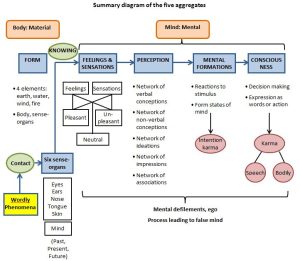19 Doctrines of Buddhism
Core Concepts of Mainstream Buddhism
The following core teachings are regarded as “mainstream” Buddhism since these ideas appear in Buddhist groups from the time of the Buddha until the present and are accepted by Theravada, Mahāyāna, and Vajrayāna Buddhist groups. The most essential teachings are contained in the Four Noble Truths. As you read through this section, notice the pattern of the four noble truths: the first three truths describe the situation, diagnose the cause, and show the solution. The fourth noble truth shows the method of reaching the solution of nirvana.
First Noble Truth: Describing the Condition
The first noble truth describes our situation. As a being in samsara, the realm of birth and death, everything that we experience is impermanent, constantly changing, and without an essence or permanent “self”.
It does not mean that there is no “you”, but that we all construct an identity based on things that are impermanent and changing. From a Buddhist perspective, the easiest way to get a sense of this is to follow your breathing. As you become aware of your in-breath and out-breath, you see how your experience is continually shifting and changing.
The first noble truth is the awareness of unsatisfactoriness. Sometimes this is translated as “suffering” but it points to something deeper and wider than simply feeling pain. It really means that no matter how hard you try, you cannot control the circumstances of your experience which is continually changing.
Buddhist teachers developed a systematic view of how contact with the world through the senses operates. The world is divided into one material and four mental types or collections of experience. These five skandhas, or collections are different ways that we experience the world as
- form – your body and the physical world
- feelings of pleasant, unpleasant, and neutral sensation
- perceptions
- mental formations: impulses and reactions
- consciousness
The following chart outlines how these five processes or heaps of experience work.

Second Noble Truth: Diagnosis of the Cause of Suffering
The second noble truth points to the cause of unsatisfactoriness. The cause of dissatisfaction is NOT the fact that there is impermanence. The cause of suffering is our ignorance and the fact that we cling to impermanent things as if they were permanent and under our control. Some people reduce this “cause” to desire, but this is incorrect. Since we are living beings, desire is part of our condition and cannot be changed. What can be changed is how you respond to desire: what actions you take. Gradually developing the wisdom not to act on impulse and ignorance is the way that beings can be transformed.
The “three poisons” of greed, hate, and delusion show how this works in our daily life. When you see something you want, you can become restless and unhappy until you get it. But if you come in contact with something you do not like, then you try to avoid it. Thinking that you can control things so that you only have what you want and avoid what you do not want is the cause of unhappiness according to Buddhist thought. Finally, delusion is simply being confused about the nature of suffering, impermanence, and non-self.

Third Noble Truth: Cure of Suffering
For Buddhists, the ultimate goal of spiritual practice is nirvana. Nirvana literally means “to extinguish.” When the three poisons of greed, hatred, and delusion are extinguished like a flame, then there is peace. We don’t know what this is like, we can only imagine it. Now and then we get a taste of it when, for a moment, you do not feel pushed to do anything, your mind simply relaxes and just “is”.
Although Westerners commonly think of nirvana as a kind of heaven where everything is pleasant, the word nirvana simply means to stop greed, hate, and delusion and to extinguish the kind of mind that drives us forward into clinging.
Nirvana is a state that is experienced in life. The Buddha experienced it in enlightenment and for the rest of his life. Disciples of the Buddha applied his teachings and received the title of arhat when they understood his teachings thoroughly and also became free of greed, hatred and delusion.
Fourth Noble Truth: Method for Ending Suffering
Finally, the fourth noble truth explains how to achieve nirvana through the eightfold path. It is both a method and a guide for ethical life. In Buddhism there is no idea of sin. Every thought and action is classified based on whether it brings you closer to realization of nirvana or not. Skilled thoughts and actions lead toward realization. Unskilled thoughts and actions keep you trapped in samsara, constant wandering through rebirths.
The Eightfold Path has three main divisions, called the three trainings: wisdom, morality, and concentration.
- Wisdom: Wisdom in Buddhism means seeing the world as it is. In Buddhism this means ultimately to see the world as the Buddha sees it. Before full enlightenment, though, it is wisdom that helps the practitioner get started on Buddhist practice. Everyone has at least a little wisdom. Wisdom has two aspects:
- Right Understanding: begins with understanding karma and rebirth and taking responsibility for one’s own actions.
- Right Intention: training the emotions to give up greed, hate, and delusion and develop peace and kindness towards others.
- Morality: Morality or ethics are essential to Buddhist practice. Morality is the foundation of a life that is free from unskillful acts and states of mind. It is expressed in actions of speech, mind, and body. Morality has three aspects:
- Right Speech: not lying, not speaking harshly or using speech to harm others.
- Right Action: not taking what is not given, not hurting others through physical actions.
- Right Livelihood: not supporting yourself by harming others through violence, greed, or deceiving others.
- Concentration: Concentration is the ability to stay focused and to train the mind. This is done in daily life and in meditation. Concentration has three aspects:
- Right Effort: to avoid unskillful states of mind and develop skillful states of mind.
- Right Mindfulness: awareness of mental and physical experiences as they arise.
- Right Concentration: deeper levels of calming practices.

The eightfold path is not a straight line from beginning to end. Think of it as a dynamic wheel with all eight aspects continually interacting. The wheel in Buddhism also symbolizes the movement of the Dharma or teachings throughout the world.
